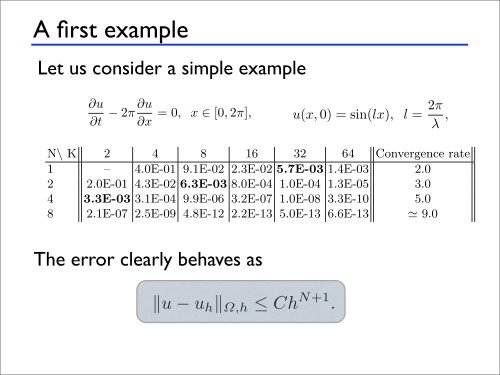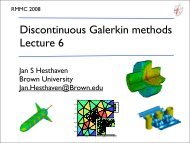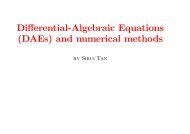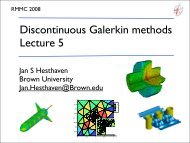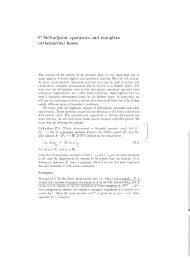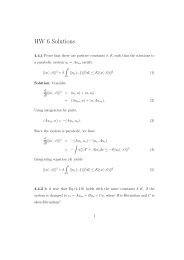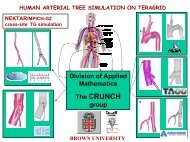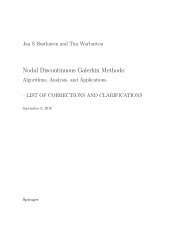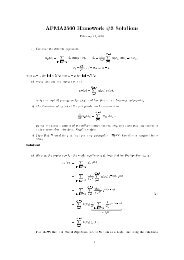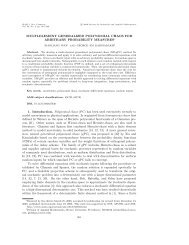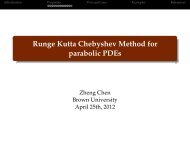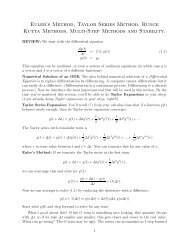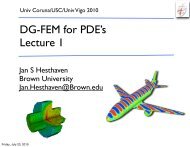Discontinuous Galerkin methods Lecture 1 - Brown University
Discontinuous Galerkin methods Lecture 1 - Brown University
Discontinuous Galerkin methods Lecture 1 - Brown University
Create successful ePaper yourself
Turn your PDF publications into a flip-book with our unique Google optimized e-Paper software.
L 2 -errors when solving the wave equation using K elements each<br />
on of the number of elements, K, and the order of the local approximation, N. In<br />
Example 2.4. Consider Eq. (2.1) as<br />
results,<br />
A first example<br />
as . Notewe that observe forseveral N = things. 8, the First, finite the scheme precision is clearly dominates convergentand and dest there<br />
to a converged result; one can increase the local ∂uorder<br />
of ∂uapproximation,<br />
N, and/or<br />
se the number of elements, K.<br />
− 2π =0, x ∈ [0, 2π],<br />
∂t ∂x<br />
Let us consider a simple example<br />
er Eq. (2.1) as<br />
∂u ∂u<br />
− 2π =0, x ∈ [0, 2π],<br />
∂t ∂x<br />
ary conditions and initial condition as<br />
u(x, 0) = sin(lx), l = 2π<br />
λ ,<br />
ength. We use the strong form, Eq. (2.8), although for this simple example, the<br />
ntical results. The nodes are chosen as the Legendre-Gauss-Lobatto nodes as we<br />
il in Chapter 3. An upwind flux is used and a fourth-order explicit Runge-Kutta<br />
to integrate the equations in time with the timestep chosen small enough to<br />
errors can be neglected (See Chapter 3 for details on the implementation).<br />
list a number of results, showing the global L2 with periodic boundary conditions and initial condition as<br />
u(x, 0) = sin(lx), l =<br />
-error at final time T = π as a<br />
ber of elements, K, and the order of the local approximation, N. Inspecting<br />
serve several things. First, the scheme is clearly convergent and there are two<br />
result; one can increase the local order of approximation, N, and/or one can<br />
of elements, K.<br />
2π<br />
λ ,<br />
where λ is the wavelength. We use the strong form, Eq. (2.8), although<br />
weak form yields identical results. The nodes are chosen as the Legendre<br />
shall discuss in detail in Chapter 3. An upwind flux is used and a fourthmethod<br />
is employed to integrate the equations in time with the times<br />
ensure that timestep errors can be neglected (See Chapter 3 for details<br />
In Table 2.1 we list a number of results, showing the global L2-err function of the number of elements, K, and the order of the local ap<br />
these results, we observe several things. First, the scheme is clearly co<br />
roads to a converged result; one can increase the local order of approxi<br />
increase the number of elements, K.<br />
Table 2.1. Global L 2 2.1. Global L<br />
-errors when solving the wave equation using K elem<br />
of approximation, N. Note that for N = 8, the finite precision dominate<br />
convergence rate.<br />
2 -errors when solving the wave equation using K elements each with a lo<br />
roximation, N. Note that for N = 8, the finite precision dominates and destroys the<br />
gence rate.<br />
N\ K 2 4 8 16 32 64 Convergence rate<br />
1 – 4.0E-01 9.1E-02 2.3E-02 5.7E-03 1.4E-03 2.0<br />
2 2.0E-01 4.3E-02 6.3E-03 8.0E-04 1.0E-04 1.3E-05 3.0<br />
4 3.3E-03 3.1E-04 9.9E-06 3.2E-07 1.0E-08 3.3E-10 5.0<br />
8 2.1E-07 2.5E-09 4.8E-12 2.2E-13 5.0E-13 6.6E-13 9.0<br />
e rate by which the results converge are not, however, the same when changing N a<br />
fine h =2π/K as a measure of the size of the local element, we observe that<br />
u − uhΩ,h ≤ Ch N+1 2 4 8 16 32 64 Convergence r<br />
– 4.0E-01 9.1E-02 2.3E-02 5.7E-03 1.4E-03 2.0<br />
2.0E-01 4.3E-02 6.3E-03 8.0E-04 1.0E-04 1.3E-05 3.0<br />
3.3E-03 3.1E-04 9.9E-06 3.2E-07 1.0E-08 3.3E-10 5.0<br />
2.1E-07 2.5E-09 4.8E-12 2.2E-13 5.0E-13 6.6E-13 9.0<br />
asThe a measure error clearly of the behaves size of the as local element, we observe tha<br />
u − uhΩ,h ≤ Ch<br />
.<br />
it is the order of the local approximation that gives the fast convergence rate. The c<br />
es not depend on h, but it may depend on the final time, T , of the solution. To highli<br />
N+1 .<br />
r of the local approximation that gives the fast convergence ra<br />
ich the results converge are not, however, the same when chang<br />
on h, but it may depend on the final time, T , of the solution. T


